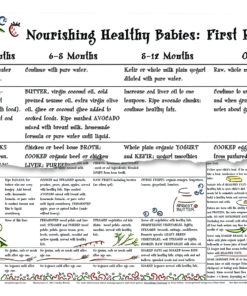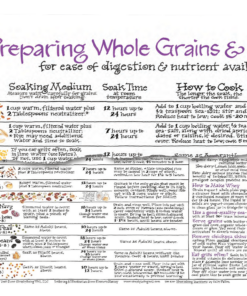‘Tis the holiday season. Unfortunately, ’tis also flu and stomach bug season. But have no fear, for the GAPS (Gut and Psychology Syndrome) diet is here. Should your tummy feel queasy and uneasy this holiday season, or any other time of year, it’s back to Stage 1 of GAPS. The diet is easy to do, whether you’ve been on GAPS or you’ve never heard of GAPS, and it will have you back on your feet soon.
Here are the foods that will support your immune system and nourish your body and soul: meat stock with good fat, quality salt and crushed garlic, and sauerkraut juice or pickle juice.
Lots and Lots of Meat Stock!
Inexpensive, easy, and fast, this immune-boosting short-cooked stock is made from meat with a joint in it (or meat with connective tissue). Think a whole chicken in a pot; chicken thighs and legs; some beef or lamb shanks; or short ribs. Many other cuts of meat would also suffice. You eat the meat and the vegetables and drink the stock.
However, people with stomach bugs don’t typically want to eat much meat, so in this case you will make a good volume of stock without too much meat. Chicken necks, backs, or wings, or a combination of all three, are safe choices. Turkey, lamb, and beef neck bones also make a good and inexpensive meat stock. Whenever possible, buy bones from pastured animals not fed on conventional grain (which means GMO soy and corn 95 percent of the time).
When making meat stock, there are two important things to consider. First, you cook it for a short amount of time: 1½ to 3 hours for chicken or poultry and 3 to 6 hours for beef, lamb, or pork. Second, you must keep the amount of water low. I have found the best ratio for achieving a gelatinous meat stock is about 1 quart of water to 1 pound of meaty bones, or a bit more water to cover. (See The Complete Cooking Techniques for the GAPS Diet for a good list of meaty bones and more information on meat stock.)
Also, for an additional immune boost to your mug, be sure to add a marrow bone or two to your meat stock. With protein, fat, collagen, and immune-boosting red blood cells, marrow is a super food. The meat stock itself contains gelatin, collagen, and amino acids—the building blocks of protein.
And before you partake, remember to add the following to your mug of stock:
Good fat: Add some good fat to every cup, in an amount that does not contribute to your queasiness. A good fat is ghee, tallow, duck fat, lard, coconut oil, or any other saturated fat. Each one contributes its own special gifts to your healing mug of stock. In general, saturated fats help your body absorb nutrients. When you are working to heal from a stomach bug, flu, or cold, consider lard from pastured pigs, which contributes important vitamin D to your healing, or antimicrobial coconut oil, which contains lauric acid that can kill harmful pathogens such as bacteria, viruses, and fungi.
Mineral salt: Add a high-quality salt to your mug for the minerals it contains. I suggest a salt with a minimum of 50 trace minerals and no anti-caking agents. Mineral salt is not pure white, a tell-tale sign that the salt has been bleached and stripped of its minerals, rather it is gray or pink or even other colors.
Raw garlic: Next in that cup is raw garlic! Start with a clove or two, peeled and pressed into your mug just prior to drinking. Not only does it taste good, but raw garlic contains antiviral and antibacterial compounds. But do not add the garlic to boiling hot stock because the heat would destroy those properties.
Now that you’ve got your mug o’ stock embellished with good fat, good salt, and garlic, it’s time to pass the sauerkraut juice!
Sauerkraut Juice (or Pickle Juice in a Pinch)
Cabbage is chock-full of vitamin C complex, and fermented cabbage even more so. Drinking the juice of sauerkraut when you are sick provides you with the vitamin C you need as well as beneficial bacteria to fight off those pathogens. Sauerkraut is easy and inexpensive to make, and you should hopefully keep some stocked in your refrigerator.
If you don’t have the time or the energy to make your own, send someone out to pick up a live sauerkraut at the store and drink juice from that. How to tell that it is live sauerkraut and thus full of all the benefits you need? It will be in a jar in the refrigerated section of the store. However, even then it may not be live, so be sure to read the label. Live kraut will list cabbage and salt, and sometimes spices and water, in the ingredients. But it will not include any chemical additives or vinegar.
Pickle juice (lacto-fermented cucumbers), typically dills, will also help. The label should list only cucumbers, salt, and water, and sometimes garlic or spices. If you don’t usually eat or drink lacto-ferments, start with 1 teaspoon 3 or 4 times per day. If you do, ramp it up to a tablespoon or more at the same rate. You can even gargle with it if your throat is sore.
Bon appetit, and feel better soon.
For more information about the GAPS diet and how it works, as well as recipes for meat stock and lacto-ferments, see my new book, The Complete Cooking Techniques for the GAPS Diet, available from Selene River Press. Contact me to talk about what ails you and how food can help at SimplyBeingWell.com.
Images from iStock/tommaso79 (main), from_my_point_of_view (post).




